
The North Hills Historic District is a residential subdivision in north Knoxville, Tennessee, United States, that was added to the National Register of Historic Places in September 2008 as a historic district. The subdivision was established in 1927 by the North Hills Corporation as a neighborhood of custom-built homes, catering to middle-class families. The historic district includes 130 houses on about 50 acres (20 ha). At the time of its listing on the National Register, it was described by the Tennessee Historical Commission as a good example of mid-20th century residential architecture.

The Williamson House is a historic house at 325 Fairfax Street in Little Rock, Arkansas, USA. It is a two-story wood-frame structure, with a gabled roof, clapboarded exterior, and brick foundation. Its roof has exposed rafter ends in the Craftsman style, and a wraparound porch supported by simple square columns. The projecting entry porch has a gable with decorative false half-timbering, and is supported by grouped columns. The house was designed by Little Rock architect Theodore Sanders and was built about 1911. Photos of the house were used in promotional materials for the subdivision in which it is located.

The Mayo House is a historic house at 302 Elm Street in Marvell, Arkansas. It is a 1+1⁄2-story wood-frame structure, clad in novelty siding, with a dormered hip roof. It was built in 1917 by H. B. Mayo, the developer of this residential subdivision, and occupied by his family 1917–20. The house is a locally distinctive rendition of Colonial Revival styling, with some Craftsman features. The east-facing front has a full-width single-story porch which wraps around to the north side, and is supported by seven fluted metal columns.

The Chautauqua Park Historic District is located on the north side of Des Moines, Iowa, United States. It has been listed on the National Register of Historic Places since 1990. It is part of the Suburban Development in Des Moines Between the World Wars, 1918--1941 MPS.

The West Washington Avenue Historic District of Jonesboro, Arkansas, encompasses a concentrated grouping of residential buildings built between 1890 and 1930. It represents the best-preserved section of the city's first planned subdivision, including thirteen historic properties on a 1-1/2 block stretch of West Washington Avenue extending east from Mclure Street and beyond Flint Street. Stylistically these houses represent a cross-section of architecture popular in the period, including Queen Anne Victorians and Tudor Revival structures. Most of the houses are built of brick, and there is one church.
The Floyd Jackson House is a historic house on Jackson Street in Hardy, Arkansas. It is a single story fieldstone structure, built in 1929. Its architecturally distinctive features include a gable roof with extended eaves and exposed rafter tails, with colored wood shingles decorating the gable ends. The interior of the house retains original pine woodwork. It is an example of American craftsman/Bungalow style.

The Waterman-Archer House is a historic house at 2148 Markham in Fayetteville, Arkansas. It is a single-story Tudor Revival brick structure, whose shape is that of an H missing an arm. To the front, it presents two gable-ended projecting sections, joined by a central portion with its roof ridge running parallel to the street. The right gable section has a large multipane window, with a trio of decorative square elements at the gable peak. The entry is found at the left side of the center section, with a window beside. Another large multipane window adorns the left gable section. The house was built in 1929, and is a distinctive local example of Tudor Revival architecture.
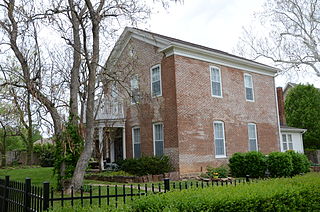
The Jackson House is a historic house at 1617 North Jordan Lane in Fayetteville, Arkansas. It is a 2+1⁄2-story L-shaped brick building, three bays wide, with a cross gable roof and a single-story ell extending to the north. A single-story portico shelters the main entrance of the south-facing facade, supported by two square columns, with a balustrade above. A small round window is located in the gable end of the main facade. The east elevation (which faces the street, has two segmented-arch windows on each level. The house was built in 1866 by Columbus Jackson, whose family lineage is said to include President Andrew Jackson.

The Jeffries House is a historic house at 415 Skyline Drive in North Little Rock, Arkansas. It is a 2+1⁄2-story wood-frame structure, finished in a fieldstone veneer, and is three bays wide, with a side-gable roof, end chimneys, and symmetrical single-story wings at the sides. The house is distinctive as a fine example of Colonial Revival architecture, rendered in the unusual veneered stone finish. Built in 1931 by the Justin Matthews Company, it was the last house Matthews built in the Edgemont subdivision before the Great Depression brought the development to an end.

The John Bettis House is a historic house on the north side of Arkansas Highway 14 in Pleasant Grove, Arkansas, a short way south of its junction with Stone County Road 32.
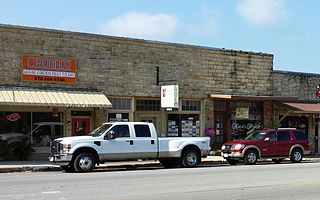
The A.B. Brewer Building is a historic commercial building on Arkansas Highway 66 in the central business district of Mountain View, Arkansas. It is a single-story structure, built out of load-bearing stone masonry, sharing party walls with adjacent buildings opposite the Stone County Courthouse, and houses three storefronts topped by a tall stone entablature. It was built in 1929 by the Brewer Brothers, who were local stonemasons.
The Sam Marshall House is a historic house in rural Searcy County, Arkansas. It is located southeast of Morning Star, on the west side of County Road 163. It is a single-story log structure, rectangular in plan, with a roof whose front gable extends over a porch supported by square columns. The logs were apparently hand-hewn, and joined by dovetailed notches. Built in 1929, it is one of the latest examples of log construction in the county.
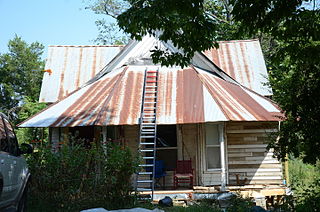
The Sanders-Hollabaugh House is a historic house on Church Street in Marshall, Arkansas. It is a single story wood-frame structure, built in a T shape with a shed-roof porch extending around the base of the T. Built in 1903, it is the best local example of a prow house, in which the base of the T projects forward. The house was built on what was then known as the Bratton Addition, a relatively new subdivision in the city, and has long been owned by the Hollabaugh family.
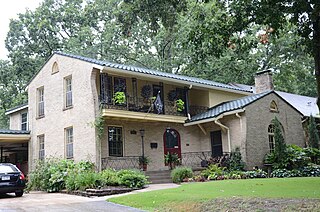
The Kleiber House is a historic house at 637 Skyline Drive in North Little Rock, Arkansas. It is a two-story frame house, finished in a buff brick veneer. Its most prominent exterior feature is a two-story porch, with wrought iron railings, and a brick extension of the side wall that curves to support the main roof as it overhangs the porch. The house was built in 1929 on speculation as part of Justin Mathews' Edgement development. Its first owner, Victor Kleiber, lost it to foreclosure during the Great Depression.

The Matthews-Bradshaw House is a historic house at 524 Skyline Drive in North Little Rock, Arkansas. It is a single-story masonry structure, its exterior clad in brick and stone. A conical turreted section with diamond-pane windows projects from one corner, and the gable above the main entrance is finished in half-timbered stucco. Built in 1929 by the Justin Matthews Company as part of its Park Hill development, it is the only example Matthews built of the French Eclectic style. It was designed by Frank Carmean, the Matthews Company architect.

The Moore House is a historic house at 20 Armistead Street in Little Rock, Arkansas. It is a 2+1⁄2-story rambling brick structure, built in 1929 to a design by Thompson, Sanders & Ginocchio. It has stylistic elements of the Tudor Revival then popular, including a tile roof, cross-gable above the main entrance, clustered chimneys with corbelled detailing, and asymmetrical arrangements of mostly casement windows. The house was listed on the National Register of Historic Places in 1982.

The Albert Retan House is a historic house at 506 North Elm Street in Little Rock, Arkansas. The house is a 2+1⁄2-story wood-frame structure, with a complex cross-gabled hip roof configuration studded by gabled projections. The exterior is finished in wooden clapboards, and it has a single-story wraparound porch with turned posts and delicate woodwork balustrade and spindled frieze. The house was built in 1893 for Albert Retan, an early investor in the Pulaski Heights subdivision where it stands.

The Waterside Street Bridge is a historic bridge, carrying Waterside Street across an inlet of Lake Number 1 in North Little Rock, Arkansas. It is a rustic closed-spandrel masonry structure, with an exterior of rough uncoursed fieldstone that rises to parapet above the side of the roadbed. It is one of four masonry bridges built between 1929 and 1939 by developer Justin Matthews as part of the Lakewood subdivision.

Park Hill is a historic house at 400 East Wahl Street in Paris, Arkansas. It is a large two-story brick building, with Mediterranean style. It has a red tile hip roof, with a three-bay porch projecting from its five-bay facade, and a porte cochere on the west side. The house was built in 1929-30 as a wedding present from Charles Wahl to his wife, and was designed by Bassham & Wheeler of Fort Smith, Arkansas. It is a distinctive local example of the Mediterranean Revival style.
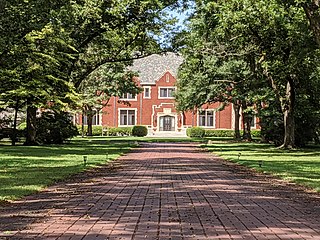
Minaret Manor is a historic mansion house at 844 West Semmes Avenue in Osceola, Arkansas. Set on a landscape 5-acre (2.0 ha) parcel, it is a large 2+1⁄2-story brick Tudor Revival building. The lower portions of the house are finished in brick laid in stretcher bond, while gabled upper areas exhibit half-timbering with brick laid in a diagonal basket weave pattern. At the right front side of the main facade is a three-story turret with conical roof. The house was built in 1948 for Andrew J. Florida, the principal owner of a real estate empire that extend across eastern Arkansas and western Tennessee.




















